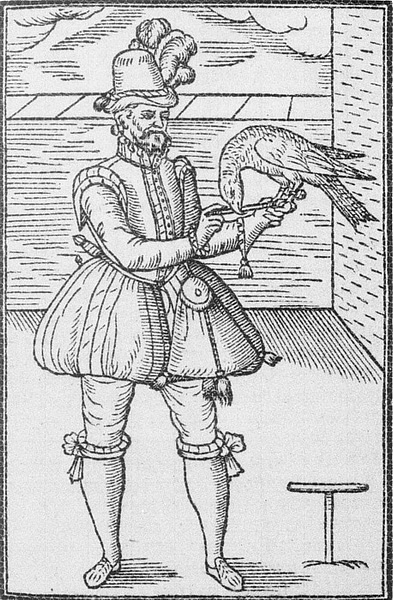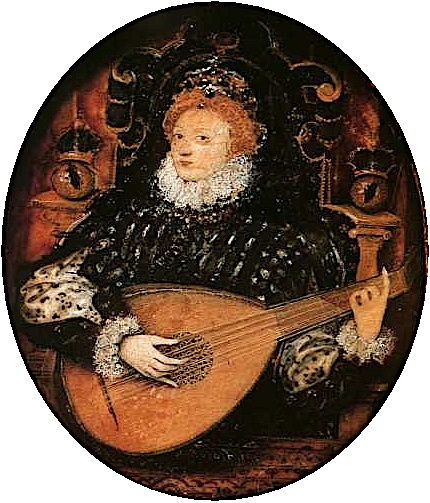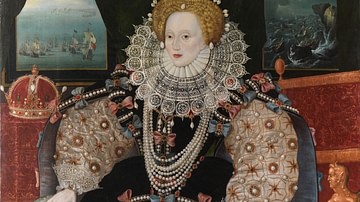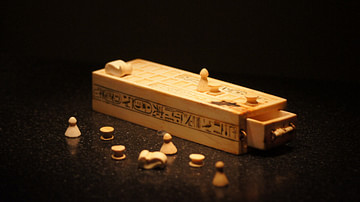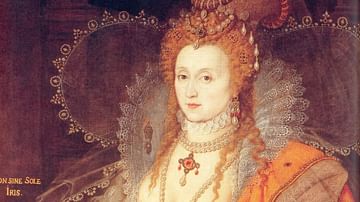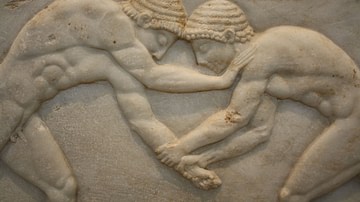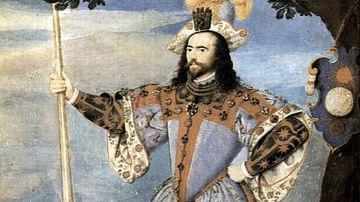Leisure activities in the Elizabethan era (1558-1603 CE) became more varied than in any previous period of English history and more professional with what might be called the first genuine entertainment industry providing the public with regular events such as theatre performances and animal baiting. Outdoor activities included tennis, bowls, archery, fencing, and team sports like football and hockey which were more violent and less rule-bound than their modern versions. Card games, board games, and gambling were all immensely popular, as were music and dancing events where people of all classes could show their skills and make new friends. The success of all these activities and the general pleasure and hilarity they produced is evidenced by the Puritan movement's hearty disapproval of just about all of them.
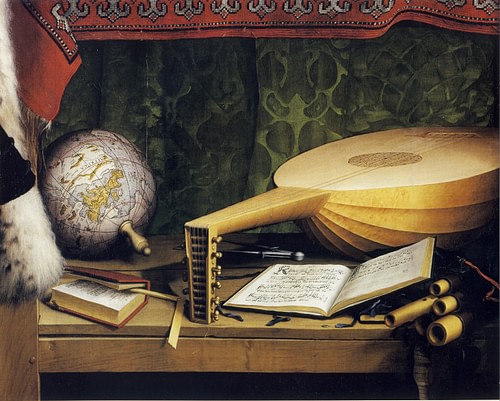
The Rich
Naturally, the rich, if not always completely idle, had more leisure time than most. When not managing their estates and servants, the wealthy looked to while away the time with a wide variety of activities. Meals were, of course, an opportunity to entertain friends and more distant relations, especially on Sundays and public holidays. Feasts with exotic menus were a chance to show off one's wealth, knowledge of culinary trends and good taste in fine dishes, cutlery, and glassware. In addition, some after-dinner entertainment might be provided by jugglers, acrobats, jesters, and musicians. Gardening was a popular pursuit with manuals containing handy tips available, and, naturally, having a garden was essential for many of the outdoor games mentioned below, not to mention having the cash for specialised equipment like rackets and board game pieces.
The Poor
The poorer members of society at least had some time for their own pursuits beyond making ends meet, typically Sunday afternoons after a visit to church had been done in the morning or on public holidays. Such public entertainments as Elizabethan theatre were cheap enough for most to be able to buy a ticket, although commoners largely preferred such blood sports as animal baiting. Country dances with musicians and fiddlers were organised and towns sometimes welcomed public performances by travelling artists such as acrobats and puppeteers, Morris dancers (traditional folk dancers who wore colourful clothes, ribbons and bells) or free concerts put on by musicians known as 'waits'. Games that did not require specialised equipment were popular, although the rules for these varied much more than the more formalised games of the aristocracy and depended very much on local traditions.
Hawking & Hunting
Hunting has always been a popular activity amongst the aristocracy in order to show their skills. In the Elizabethan period, enclosures of forest land and strict poaching laws severely restricted hunting opportunities for the lower classes but the rich continued to esteem it as part of a young man's education and as an excuse for men to ride horses and spend time in their country estates. The most common victims were deer, foxes and hares. The use of trained birds to hunt was popular, as was using the increasingly more reliable and accurate gunpowder weapons to shoot. Both hunting and hawking were pursued by men and women. Fishing using a rod was also done, especially by those with artificial lakes on their estates.
Animal Baiting
Dogs like the bulldog and bullmastiffs, bred for their savagery, were put in pits where they would tear to pieces a single bull or bear chained to the centre of the arena. One or more of the dogs were put into the pit and went for the bull or bear's ears or nose, holding on grimly until the bigger animal collapsed from exhaustion. A judge likely decided when the match was over as bears were too rare to be killed each bout. Cock-fighting, where two trained roosters fought to the death was held in similar circular arenas and was equally popular. These bloodsports attracted bets on the likely winner and, in the case of bullbaiting, the meat of the dead animal was eaten. The arena for these sports likely influenced the later theatres for drama.
Tournaments & Martial Arts
Recreating medieval tournaments continued to be popular in the Elizabethan era. Although the arrival of gunpowder weapons meant that the full armour of the medieval knight was now obsolete on the battlefield, dressing up anyway and jousting still proved an attractive pastime for aristocrats. Tournaments were sometimes a part of festivals, as were military drills where bands of pikemen showed off their collective skills.
Fencing was by now more common than tournaments. As with jousts, the weapons used were blunted but anyone not careful enough could still sustain a serious injury. Rapiers were heavier than those used today and the combatants only had a padded jacket for protection. Some fencing matches had the participants hold shields which came in two types: the large square or circular 'target' or the small circular 'buckler'. Other variations of the sport included holding two rapiers at once or a rapier and a dagger. Alternatively, the rapier might be replaced altogether by a normal heavy fighting sword or a long wooden pole (quarterstaff).
Archery had been such an important part of medieval warfare that laws ensured even commoners had to practice at it. Even if archers, like knights, were less useful in warfare than they had been, the habit continued on into the 16th century CE and many an aristocratic garden or village green resounded to the twang of bowstrings in summer. Knife-throwing was another handy skill and was practised in the game of Penny Prick. Here, a penny was placed on top of a peg stuck in the ground and, from a distance, players had to throw their knife to dislodge the penny.
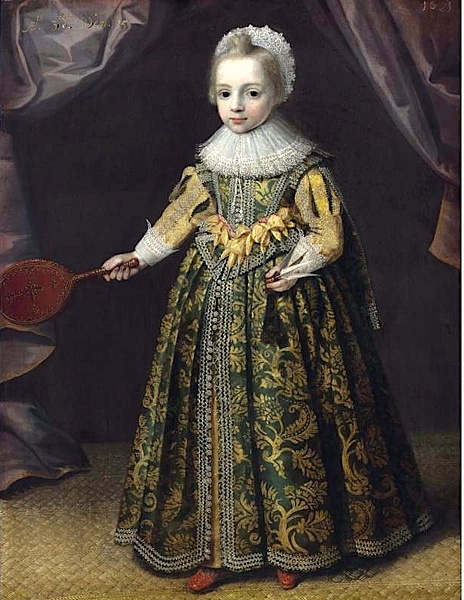
Sports
Games played on a lawn were especially loved by the Elizabethans. Bowls (as in modern lawn bowls) was popular with both men and women, the objective being to get one's weighted bowl as near to a specified target as possible. Quoits had a similar aim but one threw stones or a metal hoop at the target which was typically a stake driven into the ground. Bowling was another variation where the objective was to knock over a group of distant objects using a single wooden ball. This game went by many different names, including skittles, kittles, nine-pegs and ten-pins.
Lawn tennis required both space and equipment and so was reserved for the rich. Only played by men, rackets were made from wood with gut strings and the ball was made from tightly packed scraps of cloth. Handball was like tennis but players used their hands instead of rackets. Badminton was similar to the modern game in terms of the shuttlecock but Elizabethan rackets were made of solid wood and called 'battledores'.
Another outdoor sport was football (US: soccer) which was far rowdier than today's version. Scoring goals, then as now, was the objective but tripping opponents was positively encouraged. More traditional variations which tried to get the ball across the field by any means possible, and which similarly allowed the opposition to prevent the opponent's progress by any means fair or foul, were popular in rural settings and were more violent still. The Elizabethans also played a version of hockey, called by them bandy-ball, and cricket/rounders, known as stoolball.
Indoor Games
Probably the two most common of all indoor leisure activities was needlework for women and reading for both sexes. Printed material of all kinds, from single broadsheets to leather-bound illustrated volumes, were increasingly produced as publishers saw the potential for printing works popular elsewhere such as Renaissance Italy. Humanist philosophy was widely read and ancient authors were revisited with the first translations in English of such writers as Tacitus (c. 56 - c. 118 CE) in the 1590s CE. There were also manuals, political and religious texts, works of history, poetry and even contemporary news reports. Reading was not necessarily done silently and alone but out loud and in groups.
At the other extreme, the more physical indoor games could be moderately violent. Hot Cockles involved one player putting his head on the lap of another while everyone else slapped his behind. Only by guessing who had slapped him last could the player be released from his predicament. Blindman's Buff or Hoodman Blind was another opportunity to give a friend a clout. In this game, one player was blindfolded or hooded and everyone else dealt them a blow or 'buff' if they came close. Again, identifying one's assailant meant one could be unhooded.
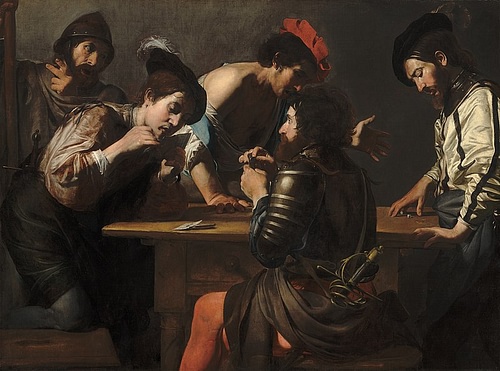
A new board game introduced from France was The Game of Goose (still widely available in Europe today in sets of board games for children). A forerunner of many modern board games, players had to roll a dice and move along squares arranged in a spiral on a printed sheet, the objective being to reach the last square before any other player. Certain squares allowed a player to roll again (i.e. one with a goose picture) or obliged them to go backwards or miss a turn. Dice games were played by everyone, the die usually being made of bone. The numbers each had a specific name derived from French (from 1 to 6): ace, deuce, tray, cater, sink, and sise. Billiards was also introduced to England in this period.
Card games were popular and played by all classes. The deck of cards was the same as today's version but without a joker and the names of some cards differed: Knave for Jack, Deuce for Two, Tray for Three. There were no numbers or letters on the cards, only pictures and the King, Queen, and Knave showed a full figure (not the half mirrored image we commonly see today). Card games included reaching a specific number, for example 31, with as few cards as possible or early versions of games still played today like Ruff and Trump (Whist) and Primero (Poker) where a player had a maximum of four cards and the highest hand was four of a kind.
Gambling was popular with all classes, especially using cards and dice but also on games like bowls where the betting was highly formalised. Essentially, any activity where the outcome was unpredictable led to Elizabethans wagering on it and even children were at it, using pebbles and cherry stones before they had money of their own.
Music & Dance
Music performed by professionals was appreciated but many people could produce their own. Popular instruments included the recorder, fiddle, bagpipes and the pipe-and-tabor (a recorder and drum combination). For the more accomplished there was the lute, virginals (a keyboard where strings were plucked), and a type of viola known as a viol. Popular songs and ballads were sung by groups, often with lively choruses and the opportunity to shout and make a general din. Many songs had parts for each singer, known as 'catches'. Elizabethan songs covered all manner of subjects from romance to commemorating military victories to chasing foxes from farmland.
Dancing, too, was as popular in the 16th century CE as it was in the centuries before and since. Not only was it good exercise and fun but it was probably the best chance for the young and unmarried to meet. There were traditional English country dances but also imports from France and Italy. For those who could afford it, there were even dancing schools. Dances frequently involved men and women as partners but part of larger groups in lines or a circle or a square. Pairs held hands or linked arms, typically with the woman on the right side of the man, and at certain points throughout, all the dancers might link. Pairs might form arches with their arms for other partners to dance through. Partners might be changed and the dance completed when one was rejoined to one's original partner. Individual steps were often less important than making sure one was in the right position in respect to one's partner and the group as a whole. The speed was not so fast, typically a lively walking pace and this left opportunity for conversation between partners. Rather than being fleet of foot, then, Elizabethans impressed others on the dance floor with their general grace of movement.
Theatre
Artists had performed mime and short plays since the Middle Ages and before but the Elizabethans began to make the whole thing more professional. Country houses of the rich and the courtyards of public inns often hosted such performances in the early part of Elizabeth's reign. The masque, where masked performers and dancers performed stories based on mythology but often with a nod to contemporary politics, continued to be popular. The performers dressed in extravagant costumes and often ended their masque by mingling and dancing amongst the audience. Drama really took off with the public, though, when the first purpose-built permanent theatre was established in London in 1576 CE.

Theatres were typically circular buildings with an open roof in the centre. Spectators watched from tiers of galleries or the flat central space in front of the raised stage. The capacity of the Globe was around 2,000, some paying as little as one penny a ticket. Viewers were treated to performances involving twelve or more permanent main actors and a number of bit-part players (all males in the 16th century CE), all performing in front of elaborately painted and moveable scenery and accompanied by a lively orchestra.
Theatres became so popular that they inevitably received a backlash from some sections of society. Puritans, who were ever-more prominent in Elizabethan society from the 1590s CE, objected to such frivolous entertainments and considered their subject matter unsuitable for commoners and likely to corrupt their minds. In addition, Puritans thought of theatres as wholly undesirable places where only the idle, immoral, and criminal elements of society gathered. Even some business owners deplored the theatres as their employees went to watch the plays which were usually held during the daytime and so working hours. As we all know, though, such protests, even if they managed to close theatres for a while, did no lasting damage to a form of entertainment which continues to be popular today.
